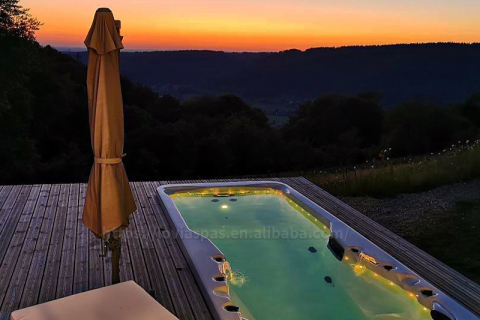
- Home
- >
News
The biggest difference between a salt water hot tub and a regular hot tub is its water treatment system. Traditional hot tubs usually use chlorine or bromine to kill bacteria and disinfect, while salt water hot tubs use a salt water system to generate natural chlorine. The core of this system is a device called a Salt Chlorine Generator.
The heating system in a hot tub is controllable, meaning that the user can turn it off as needed. On hot summer days, it is perfectly acceptable to turn off the heating system and keep the water in the tub at natural ambient temperature.
Water quality is one of the most important concerns for any hot tub user. The water in a hot tub must be clean and chemically balanced to provide users with a healthy soaking environment. If the water is not drained for a long time, water quality issues will be the first negative impact.
A standard built 10x10 deck can withstand a weight of about 5,000 pounds (about 2,268 kg). If we calculate the total weight of the hot tub to be 4,202 pounds (about 1,905 kg), then a deck of this size and design can theoretically withstand this weight, but it is close to its limit.
A hot tub cooler, also known as a water temperature regulator or hot tub water temperature cooling system, is a device specifically designed to reduce the temperature of the water in a hot tub. Unlike most hot tubs that maintain the water temperature through heating elements, coolers can reduce the water temperature so that users can still enjoy a comfortable spa experience in hot weather.
Generally speaking, the water temperature should be kept between 37-40°C (about 98-104°F), which is a range suitable for sterilization. Although it may not be a very high temperature, it helps to inhibit the growth of common bacteria and algae, thereby keeping the water clean.
For private hot tubs, which are common in home yards, Florida law is relatively relaxed. Private tubs are generally classified as part of a residential building, so in most cases, no special permit is required for installation and use. However, some specific situations may require special approvals:
Alkalinity refers to the concentration of bicarbonate ions (HCO₃⁻) in water. Alkalinity not only affects the degree of pH fluctuation, but can also directly cause pH to rise. If the alkalinity in your outdoor hot tub is too high, the water's buffering capacity will increase, which will resist the drop in pH and cause the pH to gradually rise.
According to electrical installation standards, circuit breakers should be installed at a certain height from the ground, and the specific height varies according to electrical regulations in different countries and regions. Usually, this height ranges from 4 to 6 feet (about 1.2 to 1.8 meters).
The installation of an ozone generator in an outdoor hot tub is usually combined with a filtration system. When the water passes through the filtration system, the ozone generator injects ozone into the water flow, oxidizes pollutants and bacteria in the water, and then the clean water flows back into the bathtub.
When the alkalinity in a hot tub is too high, one of the most obvious consequences is the buildup of scale. Scale is a deposit formed by the reaction of minerals in the water, especially hardness components such as calcium and magnesium, with carbonates and bicarbonates.
The maximum water temperature of modern hot tubs is usually set at 104°F (40°C), which is the internationally recognized safety upper limit. Most hot tub temperature control systems will force the water temperature to not exceed this standard.












